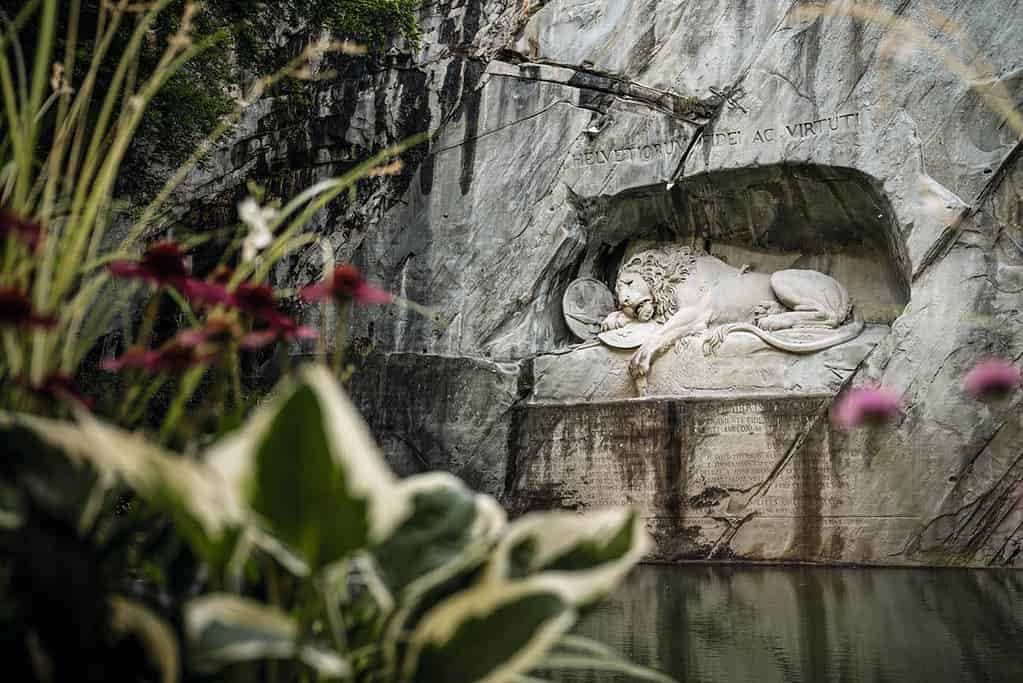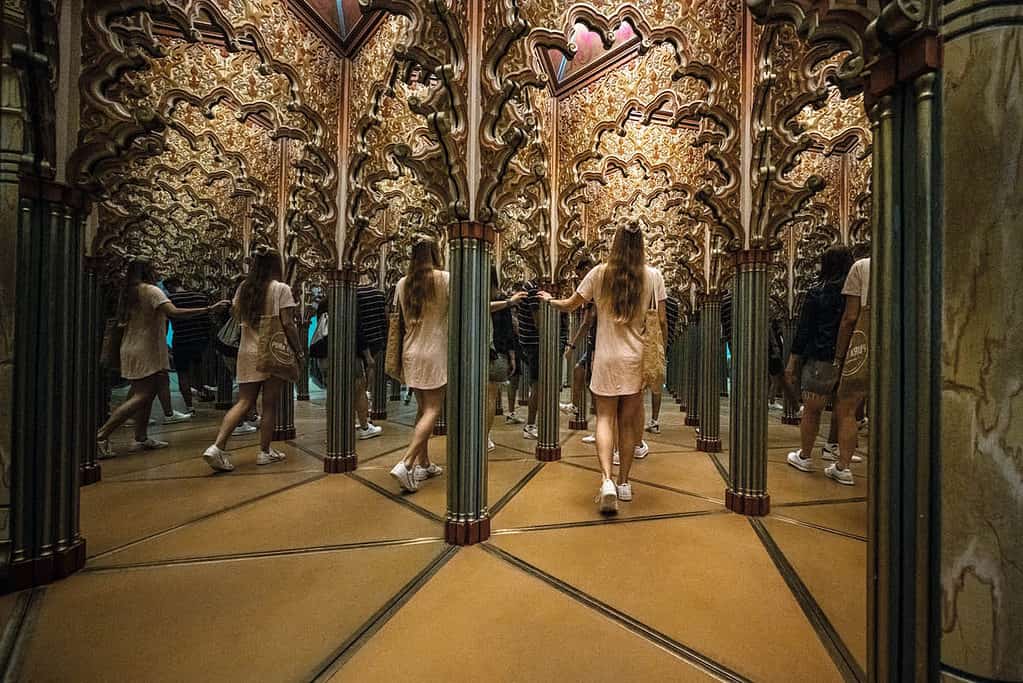Lucerne’s Glacier Garden offers visitors an impressive journey into the city’s past. Centrally located, easily accessible on foot or by car, the natural monument impresses not only with exhibitions on Ice Age glaciers but also with a mirror labyrinth and a large park. Opened in 1873, it still attracts visitors from all over the world to Lucerne. In addition to glacial pots and the Schweizerhaus, which houses the museum, the Felsenwelt takes travelers inside the mountain and immerses them in the secrets of the glacial period. The Lucerne Glacier Garden is a highlight for young and old and definitely worth a visit.
The History of the Glacier Garden
The Gletschergarten initially consisted only of the so-called glacier pots, which were discovered by chance in 1872. While trying to blast a hole for a wine cellar, Josef Amrein from Lucerne came across the shaft-like depressions in the stone. He changed his plans and instead of a wine shop opened the still famous Glacier Garden of Lucerne.
Finds from other excavations were collected and the Alpine Park was created in the surrounding area. In 1873 the glacier park was opened, and a year later the famous Schweizerhaus, which still serves as a museum building. In 1899, the Alhambra Mirror Maze was added to the complex; stuffed chamois give visitors the feeling of having traveled back in time.

After more than three years of construction, the newly built Rock World in the Glacier Garden opened in 2021, sending visitors on an underground journey. During the blasting work, more finds from prehistoric times were discovered, which tourists can now marvel at in this part of the complex.
In the summer of 2022, another attraction was added to the Glacier Garden. The Sandstone Pavilion with sandstone and excavated material from the Glacier Garden offers visitors a special exhibition and the opportunity to delve even deeper into the history of Central Switzerland.
To this day, the Lucerne Glacier Garden is a highlight of Central Switzerland and has much more to offer than “just” geological excavations.
You might also like the following article:
Things to see at the Glacier Garden
Glacier Potholes
Glacial potholes are shaft-like depressions that have been hollowed out over thousands of years by the outflowing glacial water. Through crevasses and glacial mills, the water makes its way to the bottom, the glacier bed. In the so-called meltwater streams, water eddies form at different points, where flow speeds of up to 200 km/h can prevail. Gravel particles and fine sand contained in the water are responsible for the erosion of the surrounding rock, which is also called erosion.
In the past, it was thought that the glacial potholes were cut into the rock by boulders trapped in the glacier, so-called erratic blocks. However, this theory is considered outdated.
16 of these impressive, funnel-shaped glacial pots can be admired in the Lucerne Glacier Garden. They formed the heart of the complex and were the reason for its foundation in 1873. Even today, they are a reminder of times long past when the earth was still covered in ice and snow. The remnants of the Ice Age, eroded by glacial water, are a Swiss natural monument that must be seen.
Felsenwelt (Rock World)
At the foot of a huge sandstone cliff, blasting work began in Lucerne’s Glacier Garden in 2018 for a new attraction for visitors to the facility. Three years later, the rock world was completed and opened. The underground tour was inspired by the movie “Journey to the Center of the Earth”, which is also the reason why there is no signage along the entire route. The intention was to invite visitors to explore the rock world for themselves.
The modernly designed entrance is an impressive structure in itself, but the journey continues underground. In the first rock chamber, lighting, sound and elaborately designed projections immerse visitors in the history of Lucerne sandstone: from its formation at the bottom of the sea, through mountain folding, to the present day. The “Alpenblick” viewing platform is a source of wonder for young and old alike, offering views of Lucerne and the surrounding Alpine countryside. The highlight of the tour is an underground lake that is fed by rainwater and reminds us of transience with a digital clock accurate to the second.
Alhambra Hall of Mirrors
Built in 1896 for the Swiss National Exhibition in Geneva, since 1899 part of the Glacier Garden of Lucerne is the Alhambra Mirror Maze. More than 50 mirrors were bought by the wife of the founder of the Glacier Garden under protest of many relatives and brought to Lucerne. Since then, the mirrors have delighted young and old alike, providing a welcome change of pace between glacial pots and the museum.

The magnificent decorations of the intricately crafted mirror frames are modeled on a palace from Granada in Spain, the fairy-tale Alhambra Palace. The mirror labyrinth is intended to create an illusion of the palace with its gardens, transporting visitors to the Moorish splendor for a short time before returning to the Ice Age.
The path through the mirror labyrinth is intended to give young and old alike a special experience: an expedition into the “Egoecene”. The Egoecene represents the moment in a person’s life that everyone can understand as the center of time. But even if not everyone finds what they are looking for in the mirror maze, it is fun for all ages.
Swiss House
As the former home of the founding family, the lovingly decorated house was ideally suited as a museum building in which selected objects from the past are exhibited. The diversity but also the bizarreness of the founding family is illustrated here by countless geological as well as domestic objects.
Many objects date from the 19th century, the time of the founding of the Lucerne Glacier Garden, but others are much older. The multifaceted family interests are on display here. While the women’s interest lay more in collecting furniture and other furnishings, the men of the family were devoted to geology and newly discovered archaeology. Among numerous landscape reliefs in the Schweizer Haus is the famous Glacier Relief by family friend Albert Heim, which can be admired in the newly opened Glacier Salon.
Due to the lack of space, the former residence became a museum early on. Since 1874, a year after the opening of the Glacier Garden, the famous Schweizerhaus has enriched visitors to the facility as a museum.
Alpine Park
Between rocks and lush vegetation, a narrow path leads up to the Alpine Park. As a “period-typical, still unique representative of the historic landscape garden,” according to the expert report, the park has much to offer. Rough rock, green ferns and branches mimicking railings are reminiscent of a bygone era.
On the path you can find trees that could be found 20 million years ago in the subtropical Switzerland of that time: Redwoods, ginkgoes and magnolias transport visitors back in time. In addition to the primeval vegetation, erratic blocks and old boulders are scattered around the site and marked with information signs.
An SAC hut was reconstructed in 1896 and delights tourists with its built-in diorama. With a model of the Gorner Glacier on one side and a painting of the Breithorn on the other, it transports visitors back to the days of eternal ice.
As the oldest viewing platform in Switzerland, the eleven-meter-high observation tower, to which the park owes its name, guarantees a breathtaking view of the surrounding Alps. The wooden tower is even listed as a historic monument.
Sandstone Pavilion
The newest attraction of the Glacier Garden opened this summer, in June 2022. Built from the excavated material of the Rock World, the opening of the Sandstone Pavilion finally concludes the four years of reconstruction work of the “Rock” project, which included the construction of the Rock World and a renovation of the Swiss House.
The Sandstone Pavilion was intended to be a place of dynamism that would make it possible to change exhibitions. This goal was achieved, and one room of the pavilion can even be rented for external events. In one of the rooms, a 13-minute short film about the history of the earth, climate and culture of Central Switzerland inspires visitors and is an equal successor to its predecessor, the famous “Jahrmillionen-Show”.
Changing special exhibitions in the other rooms guarantee unique experiences and impressions even when visiting the Glacier Garden again. The current exhibition “Arctic” tells about the challenges of Arctic researchers and inspires with a life-size polar bear model, which is additionally intended to draw attention to the severe consequences of global warming.
Shop & Restaurant
Between glacial pots, sandstone pavilion and mirror labyrinth, the family-friendly Bistro Salwideli invites you to take a short break. Newly built in 2020, the restaurant with its historic ambience offers an extraordinary experience for the palate. Incorporated into the overall architectural concept of the listed Swiss house, the restaurant also makes an excellent event location for personal occasions.
Using local ingredients from the canton of Lucerne, all dishes and drinks are produced as sustainably as possible and guarantee a very special treat. A specialty of the bistro kitchen is the homemade hot dog. With bread from a local bakery, sausage from the local butcher and spiced ketchup developed in Lucerne, this hot dog is a local specialty that cannot be missed during a visit to the Glacier Garden.
In the store, there is a souvenir for everyone to get excited about. Whether geological gems such as rock crystals, local care products, old-fashioned postcards or edible souvenirs that will tantalize the palate long after the visit – in the souvenir store, everyone can take home a very personal piece of the Glacier Garden.
How to get there
Centrally located, the Glacier Garden of Lucerne is ideal for spontaneous excursions and is also uncomplicated to reach and easy to find. Both on foot and by car, the facility is easy to reach. Parking spaces are plentiful in the area, but the way through the old town is only by foot due to the pedestrian zone.
From the train station through the old town of Lucerne, however, the walk takes only 15 minutes and allows visitors to enjoy the breathtaking view of Lucerne’s cultural and historical splendor.
The Löwenplatz bus stop for arriving by bus is located in the immediate vicinity of the Gletschergarten, as is the parking lot of the same name. The square is named after the world-famous Lion Monument, which should not be forgotten on any trip to Lucerne.
The Gletschergarten is open daily from 10 am to 6 pm, but from November to March it closes an hour earlier due to the winter season. A visit to the facility is perfect as a half-day excursion destination for the whole family.
You might also like the following article:
Final Thoughts about the Lucerne Glacier Garden
The Lucerne Glacier Garden is a highlight for the whole family. In addition to the underground tour, mirror maze and museum, new attractions are regularly added to the facility. The Glacier Garden offers entertainment and history lessons for the whole family. Centrally located, open daily and barrier-free accessible, the Gletschergarten offers a journey into the past and should not be missed during a visit to Lucerne.
